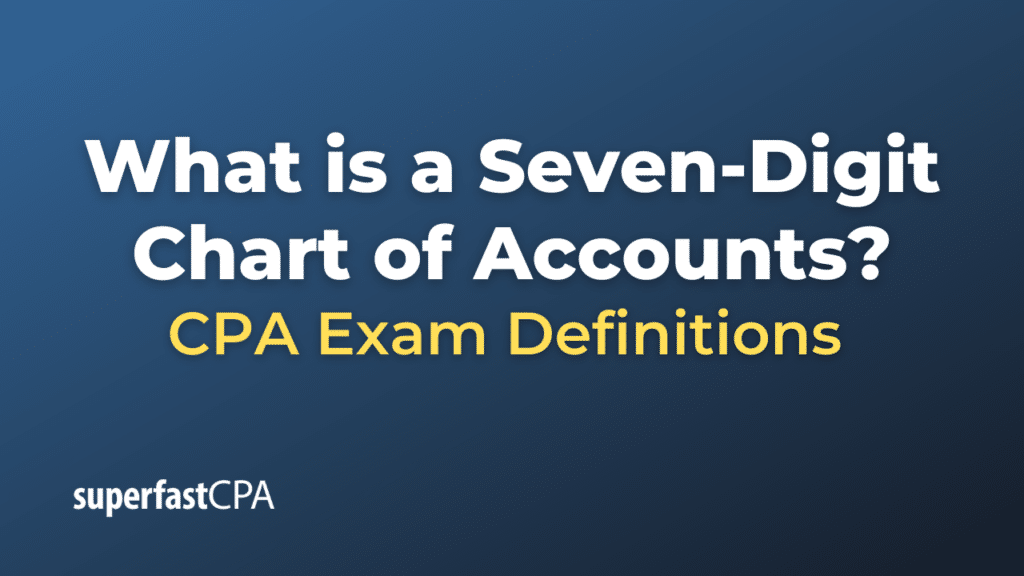Seven-Digit Chart of Accounts
A seven-digit chart of accounts is a structured numbering system used in accounting to classify and organize financial transactions recorded in the general ledger. The length of the account number, in this case seven digits, indicates a more detailed or complex chart of accounts. Each digit or combination of digits within the number can signify a specific classification, location, department, project, or any other segment relevant to the organization’s operations.
Here’s a simplified breakdown of how a seven-digit chart of accounts might be structured:
- Digits 1-2: Major Category
- For instance, “10” might represent assets, “20” for liabilities, “30” for equity, “40” for revenue, and “50” for expenses.
- Digits 3-4: Sub-Category within the Major Category
- Within assets (10), “1100” might represent current assets, while “1200” could be fixed assets.
- Digits 5-6: More detailed classification
- Within current assets (1100), “1110” might signify cash, “1120” for accounts receivable, and so forth.
- Digit 7: Specific account or further granularity
- Within cash (1110), “11101” might be the operating bank account, “11102” could be a savings account, and “11103” might represent petty cash.
This is a simplified representation, and real-world applications might differ. The benefit of using a seven-digit (or similarly extended) chart of accounts is that it offers a high level of granularity and specificity. Larger organizations or those with diverse operations often need such detailed accounting structures to manage, track, and report financial activities accurately.
However, it’s essential for companies to choose a chart of accounts structure that aligns with their size and complexity. Smaller entities might find such detailed charts burdensome and unnecessary. Always design a chart of accounts keeping in mind clarity, usability, and the specific needs of the organization.
Example of a Seven-Digit Chart of Accounts
Let’s consider a fictional manufacturing company that has multiple production plants across the country. They might use a seven-digit chart of accounts to classify transactions based on type, location, and department. Here’s how their chart could be structured:
Example: Seven-Digit Chart of Accounts for XYZ Manufacturing Co.
- Digits 1-2: Major Category
- 10: Assets
- 20: Liabilities
- 30: Equity
- 40: Revenue
- 50: Expenses
- Digits 3-4: Sub-Category within the Major Category
- Within Assets:
- 1100: Current Assets
- 1200: Fixed Assets
- Within Assets:
- Digits 5-6: Location or Department Classification
- 01: New York Plant
- 02: California Plant
- 03: Texas Plant
- Digit 7: Specific Account or Further Detail
- Within Current Assets for the New York Plant:
- 1100011: Cash in Bank – New York Plant
- 1100012: Accounts Receivable – New York Plant
- 1100013: Inventory – New York Plant
- Within Current Assets for the California Plant:
- 1100021: Cash in Bank – California Plant
- 1100022: Accounts Receivable – California Plant
- 1100023: Inventory – California Plant
- And so on for the Texas Plant and other categories.
- Within Current Assets for the New York Plant:
With this structure, when the finance team or management reviews the general ledger or financial statements, they can quickly identify not only the type of transaction but also the location or department associated with it.
If the New York Plant manager wants to know how much cash they have on hand, they can refer to account 1100011. Similarly, if the company’s CFO wants a total of all accounts receivable across all plants, they can sum the values from accounts 1100012, 1100022, and corresponding AR accounts for other locations.
This example highlights how a seven-digit chart of accounts can help a complex organization maintain clarity in its financial reporting and analysis. However, it’s essential to note that while this offers granularity, it can also introduce complexity. Proper training and documentation are crucial to ensure everyone understands and uses the system correctly.












